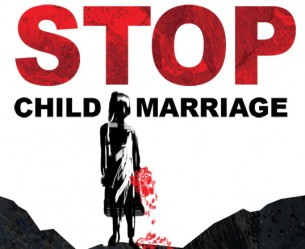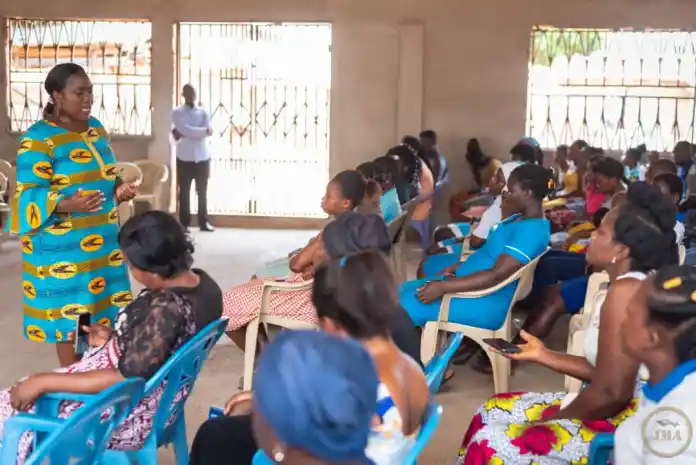A GNA Feature by Christabel Addo
Accra, Aug. 03, GNA – The overwhelming determination of Implementing Partners (IPs) and Civil Society Organisations (CSOs) to sustain community engagements within selected districts and regions, has contributed immensely to decreasing the rate of Child Marriages (CM) in Ghana.
They have been in constant engagement with traditional, religious, and other opinion leaders, adolescents, and parent groups, providing them with vital information and education on Adolescent Sexual and Reproductive Health (ASRH), Sexual and Gender-Based Violence (SGBV) including Domestic Violence (DV), and the negative long-term implications of CM and Adolescent Pregnancy (AP), particularly on women and girls.
Through sustained advocacy and education within affected regions and communities, increased awareness is being created among the populace, leading to the current national CM prevalence of 19 per cent, from a much higher rate in earlier years.
The positive effect of these information and education, is drawing more community members to rally under various implementing Project activities by IPs and CSOs in their localities, to help rescue girls from marring too early and handing over perpetrators to face the law, while encouraging adolescents (girls and boys) to seek knowledge through the “Safe Space Systems.”
INTERVENTIONS
The United Nations Population Fund, which is the UN Agency for Sexual and Reproductive Health, has since 2016, been pushing for partnerships, policies, legislations, programmes and the implementation of global activities that upholds the rights, health, dignity and safety of women and girls.
The Agency in collaboration with the United Nations Children’s Funds (UNICEF), is currently implementing the UN Global Programme on ending CM in 12 countries including Ghana.
UNFPA Ghana, is working with the Ministry of Gender, Children and Social Protection, (MoGCSP), Regional Coordinating Councils (RCC) and Ghana Health Service (GHS), Planned Parenthood Association of Ghana (PPAG), Purim African Youth Development Platform (PAYDP), International Needs Ghana (INGH), on various projects in some communities within selected district and regions.
The objectives among others, are to identify the sources of these unfair treatment against women and girls, engage and holistically empower the communities particularly adolescents, with accurate and life-changing information on their sexuality, health and rights, via the such as ‘Safe Space System for girls’ and ‘Men and Boys Clubs,’ so they can advocate themselves and even persuade their families to delay their marriages, among other things.
The projects also offer skills training for out of school adolescents as part of the interventions to prevent adolescent pregnancies to sustain the gains.
Community leaders including chiefs and queen mothers, Assembly members, religious leaders, family heads, parent and youth groups, are also engaged and given the required training to be able to assist as facilitators of youth programmes, or as ‘Champions’ to rescue girls being married off, prevent the occurrences of Adolescent Pregnancies (AP), and other harmful cultural practices like Female Genital Mutilation within their communities.

Mrs Thywill Eyram Kpe, the Volta Regional Director for the Department of Gender, in an interview with the Media and Communication Advocacy Network correspondent at the Ghana News Agency, said the Department, has for the past two years been working with UNFPA Ghana under Phase II of the Global Programme on ending Child Marriage and recorded some impacts.
PROGRESS
Current data from the Multiple Cluster Indicator Survey (MICS 2017/2018), shows a decline in the rate of CM, from about 29.3 per cent in 2011, to a current 24 per cent, “So we know that we are doing some good work, but we need to see greater reduction in the actual number of girls getting married or co-habiting,” she said.
We have seen some gradual progress, for instance in adolescent pregnancy rates decreasing from above 14 per cent, to 13 per cent in 2022, “though not very significant, but we are determined to do more to accelerate the progress of ending CM,” she said.
She attributed the impacts to the commitment of trained peer facilitators and teacher mentors working within Girl’s Clubs or Safe Spaces, to engage others on topics and discussions that enlighten them to make informed decisions and choices.
Also, the engagement of Community Parent Network Advocacy Groups now working in seven communities within three districts of the Volta region, to other parents on key issues like responsible parenting, parent-child communication, ASRH, CM and child rights, has enhanced awareness, and is giving much impetus for reversing the negative trends.
Again, the use of drama skits via community radios and information centres, to educate and generate public discussions on key issues has been a remarkable progress, she said.
Mrs Kpe stated the Gender Equality Male Schools, which is an annual school bringing together men and boys for education and discussions on issues like masculinity, SRH and Rights, CM and its implications for women and men alike, Gender equality, SGBV and its negative impact on men and families among others, are contributory effects of the decline.
She explained that the boys engaged are selected from the same beneficiary schools as the girls for the mentorship activity, so that they can complement each other’s efforts in their school clubs.
Apart from its annual tracking of programmes, the Department also holds quarterly meetings with these groups, collects regular reports from teacher mentors and pays intermittent visits to the schools to ascertain progress and impact of their activities.
LESSONS LEARNT
She noted that coordinating issue of CM is difficult, so the region has currently assembled all departments, agencies and organisations providing support towards ending CM, to work as a team, to prevent duplication on functions and preserve scarce resources.
“So, we have a platform for quarterly meetings with all these institutions, to discuss the essential service packages for victims of SGBV, so members give their reports on trends of SGBV, CM, and APs among others within their operational areas and their contributions to addressing these issues.”
“For our region, we realised that when it comes to CM, yes, there are situations where we’ve had reports about children being actually married off, and these mostly happens in Muslim communities, but then when it comes to the general populace, it is adolescent pregnancies that drives most of girls into co-habitation with the men responsible for their pregnancies,” she said.
“So, we have a lot of girls living with such men, and while some have permanently dropped out of school, others have resumed their education after childbirth while still living with the man.”
Mrs Kpe said in one of the communities, they discovered that some of the girls were living with the fathers of their babies, and still coming to school from these homes, confirming that CM still exist in pockets of rural settlements in the form of co-habitation, being fueled by adolescent pregnancy.
She said the law describes child marriage as any formal or informal union where one of the parties is a minor or below age 18 years and it is prohibited under the Children’s Act of 1998, Act 560, (Section 14) for any child under 18 years to enter, be forced into marriage, or “betrothed to be the subject of a dowry transaction, therefore co-habitation is a violation and perpetrators can incur court fines or be jailed.
RECOMMENDATIONS
She Call for strict enforcement of the laws to hold parents and societies responsible for any acts of abuses of children’s rights, no matter the situations they may find themselves in, and advised parents against sending their pregnant daughters away from their homes.
“This is because per the law parents have no locus to send a girl below age 18 years out of the house because she is pregnant.”

Similarly, “For a man who takes in a child under 18 years, who decides on her own, without parental consent to go and live with him, can be cited for abduction and duly face prosecution or a fine,” she said.
Mrs Kpe said from the peripheral laws, some of these issues are being handed without any problems, but there is the need to look at the concerns and what other existing or new legislations can prosecute some of these behaviours and manage these issues such that they do not negatively affect the child.
“So, for me, it is not much about the laws, but the method of implementation, enforcement and prosecution of offenders within communities remains a huge concern,” she said.
She indicated that for change to happen, some of the concerns raised now must be pursued and addressed, to build trust in individuals and communities in the legal processes and report CM issues.
Child marriage is a devastating Human Rights that robs many girls of their childhood, education, and health, and though the menace is punishable under the Criminal Offences Act of 1960, and other international Conventions like the UN Convention on the Rights of the Child, most perpetrators are not prosecuted.
The UN resolution reinforces international consensus among its Member States, as well as UNFPA and UNICEF, that ending CM is a vital development and Human Rights issue, hence need to accelerate efforts to achieve the desired impact.
GNA